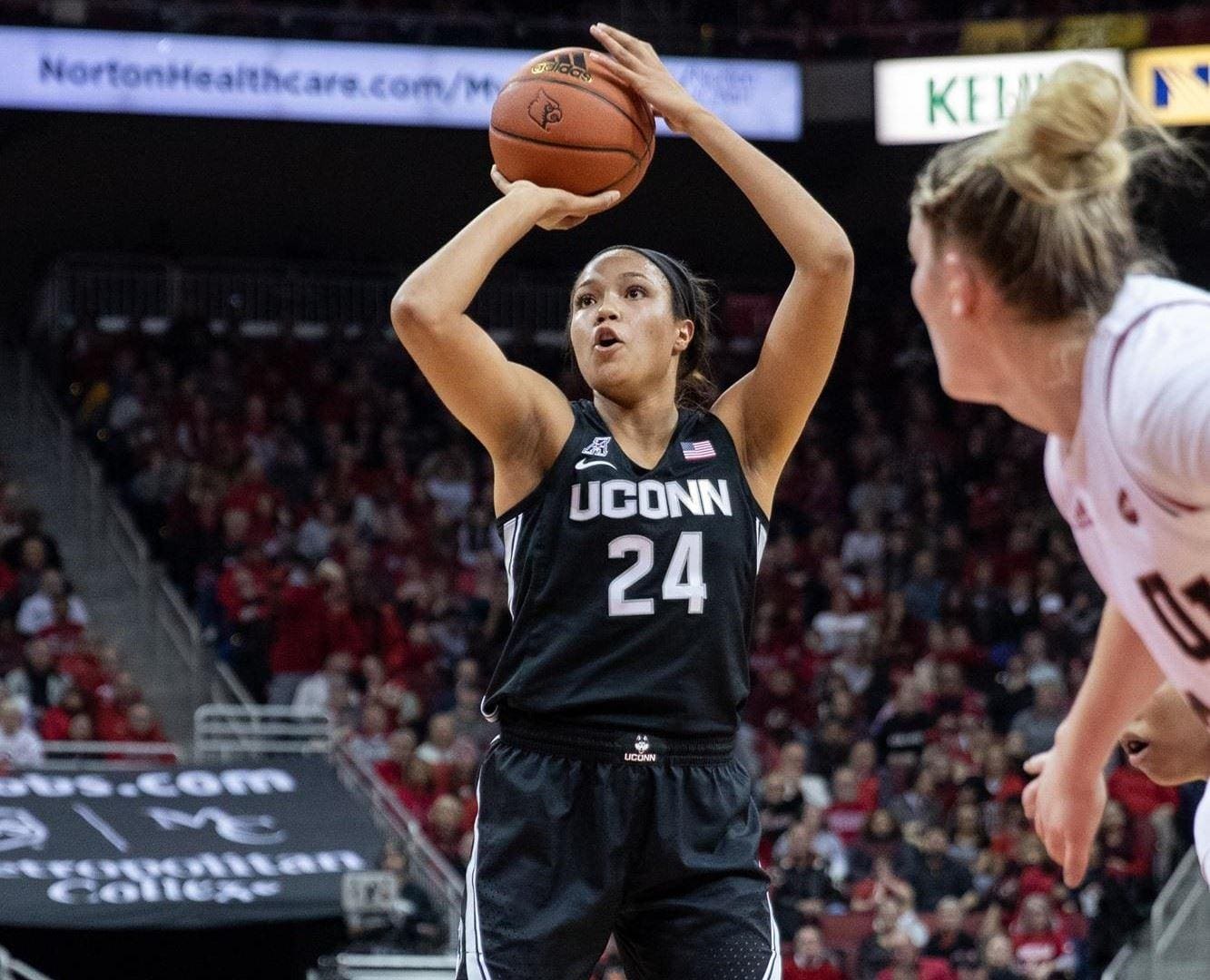Search Posts
Recent Posts
- Rhode Island Weather for June 4, 2025 – Jack Donnelly June 4, 2025
- Sour Grapes time! – Tim Jones (meet Tim at AnimeCon) June 4, 2025
- Lawsuit filed to stop Empire Wind Project by 4 environmental groups and fishermen June 4, 2025
- It is what it is: 6.4.25 – Jen Brien June 4, 2025
- New ALS treatment by PathMaker Neurosystems. Co. funded by RI Life Sciences Hub to come to RI. June 3, 2025
Categories
Subscribe!
Thanks for subscribing! Please check your email for further instructions.

March Madness NCAA Women’s Tournament – John Cardullo
by John Cardullo, sportswriter
As the Men’s NCAA Basketball bracket continues to surprise everyone, on the ladies side the “madness” is a lot truer to form. As the NCAA Men’s and Women’s tournaments hit the halfway point, the women’s bracket has had its share of upsets, 7 to be exact, but nowhere to the amount of the 17 that has happened in the Men’s tournament.
San Antonio, Texas is the host city for this year’s Women’s National basketball tournament. The NCAA decided to isolate both the Men’s (Indianapolis), and Women’s event, similar to what professional sports did in both Hockey and Basketball, having all their games in what became known as the “bubble”, and determined to plow through the pandemic and complete an already abbreviated season and crown a National Championship.
The Women’s tournament had not even begun when a controversy emerged. A player on one of the contending teams called out the NCAA for its inequality of the way the training and weight room was set up for the players. Spotlighting a single rack of “free weights” as what the NCAA powers-to-be determined as an adequate training facility for the women, while their male counterparts had a full weight and training room complete with a sports trainer and tables. After the video went viral, and hit the news, the NCAA, trying to save face and avoid a controversy, had shipped in an equal amount of equipment for the women within hours. Crisis avoided; but the message was delivered, the days of inequality will no longer be tolerated.
As far as the tournament itself, teams were seeded in regions that were known by the locals rather than North, South, Mid-West and West. They were called The Alamo, River Walk, Mercado and Hemisfair regions.
In the Alamo region with one upset, all the higher seed teams advanced. #1 Stanford; #2 Louisville; #3 Georgia; #5 Missouri State; #6 Oregon; #7 Northwestern; #8 Oklahoma State all advanced to round two. The only upset was #13 seed Wright State knocked out Arkansas with a 66-62 win. In this “region’s” second round all the upper teams advanced into the sweet 16. #1 Stanford beat #8 Oklahoma State 73-62. #2 Louisville topped #7 Northwestern 62-53; #5 Missouri State routed #13 Wright State 64-39, ending their Cinderella run. #6 Oregon upset #3 Georgia 57-50 advancing to the sweet 16 and posting two upsets in this region.
The Hemisfair region had no first-round upsets, #1 South Carolina; #2 Maryland; #3 UCLA; #4 West Virginia; #5 Georgia Tech; #6 Texas; #7 Alabama and #8 Oregon State all moved on to round two. #1 seed South Carolina took out #8 seed Oregon State 59-42; as #2 Maryland stormed past #7 Alabama 100-64. In back-to-back upsets, #5 seed Georgia Tech ripped #4 seed West Virginia 73-56 while #6 seed Texas sent #3 seed UCLA home with a 71-62 win. Half the sweet 16 round has been set up with a total of 4 upsets in the tournament.
As the tournament switched to the River Walk region, the upper seeds held true to form advancing to the second round. #1 UCONN; #2 Baylor; #3 Tennessee; #4 Kentucky; #5 Iowa; #6 Michigan; #7 Virginia Tech and #8 Syracuse as in the Hemisfair region all moved on. The second round had #1 seed UCONN surge past Syracuse and #2 seed Baylor blow past Virginia Tech 90-48 but like the Hemisfair region two upsets were the news of round two. #5 Iowa punched #4 seed Kentucky’s ticket back home while #6 Michigan topped Tennessee 70-55 living to go onto to play in the sweet 16.
To this point the tournament had 6 upsets, far below what was happening in the men’s bracket, but this was not a race to see which tournament had the most upsets, it was the run to the National Championship.
The Mercado region had #1 seed North Carolina State, #2 Texas A&M; #3 Arizona; #4 Indiana; #7 Iowa State and #8 South Florida winning their opening round games. #5 seed Gonzaga lost to #12 seed Belmont 64-59 to record the regions first upset and in the next game #11 seed BYU nipped #6 seed Rutgers 69-66. The race for the final teams to make it into the sweet 16 continued as all the upper seeds moved on to set up the final run to the championship. #1 NC State downed South Florida 79-67; #2 Texas A&M edged out Texas A&M in a trilling 84-82 win; #3 Arizona topped #6 BYU 52-46 and #4 Indiana ended Belmont’s run with a 70-48 win. Setting up a NC State, Indiana, Arizona and Texas A&M advancement and the final piece into the Sweet 16.
The race to the National Championship will move this weekend as the Sweet 16 final teams get set to play. The remaining teams are all traditional women basketball powers with all four regions number 1 & 2 seeded teams still in the running. The one sure thing is that despite the eight upsets that have taken place, the run for the championship is going to be at full speed and who know what unknown upsets are yet to happen, they do not call this time a year March Madness for nothing!
As the Men’s NCAA Basketball bracket continues to surprise everyone, on the Ladies side the “madness” is a lot truer to form. As the NCAA Men’s and Women’s tournaments hit the halfway point, the women’s bracket has had its share of upsets, 7 to be exact, but nowhere to the amount of the 17 that has happened in the Men’s tournament.
San Antonio, Texas is the host city for this year’s Women’s National basketball tournament. The NCAA decided to isolate both the Men’s (Indianapolis), and Women’s event, similar to what professional sports did in both Hockey and Basketball, having all their games in what became known as the “bubble”, and determined to plow through the pandemic and complete an already abbreviated season and crown a National Championship.
The Women’s tournament had not even begun when a controversy emerged. A player on one of the contending teams called out the NCAA for its inequality of the way the training and weight room was set up for the players. Spotlighting a single rack of “free weights” as what the NCAA powers-to-be determined as an adequate training facility for the women, while their male counterparts had a full weight and training room complete with a sports trainer and tables. After the video went viral, and hit the news, the NCAA, trying to save face and avoid a controversy, had shipped in an equal amount of equipment for the women within hours. Crisis avoided; but the message was delivered, the days of inequality will no longer be tolerated.
As far as the tournament itself, teams were seeded in regions that were known by the locals rather than North, South, Mid-West and West. They were called The Alamo, River Walk, Mercado and Hemisfair regions.
In the Alamo region with one upset, all the higher seed teams advanced. #1 Stanford; #2 Louisville; #3 Georgia; #5 Missouri State; #6 Oregon; #7 Northwestern; #8 Oklahoma State all advanced to round two. The only upset was #13 seed Wright State knocked out Arkansas with a 66-62 win. In this “region’s” second round all the upper teams advanced into the sweet 16. #1 Stanford beat #8 Oklahoma State 73-62. #2 Louisville topped #7 Northwestern 62-53; #5 Missouri State routed #13 Wright State 64-39, ending their Cinderella run. #6 Oregon upset #3 Georgia 57-50 advancing to the sweet 16 and posting two upsets in this region.
The Hemisfair region had no first-round upsets, #1 South Carolina; #2 Maryland; #3 UCLA; #4 West Virginia; #5 Georgia Tech; #6 Texas; #7 Alabama and #8 Oregon State all moved on to round two. #1 seed South Carolina took out #8 seed Oregon State 59-42; as #2 Maryland stormed past #7 Alabama 100-64. In back-to-back upsets, #5 seed Georgia Tech ripped #4 seed West Virginia 73-56 while #6 seed Texas sent #3 seed UCLA home with a 71-62 win. Half the sweet 16 round has been set up with a total of 4 upsets in the tournament.
As the tournament switched to the River Walk region, the upper seeds held true to form advancing to the second round. #1 UCONN; #2 Baylor; #3 Tennessee; #4 Kentucky; #5 Iowa; #6 Michigan; #7 Virginia Tech and #8 Syracuse as in the Hemisfair region all moved on. The second round had #1 seed UCONN surge past Syracuse and #2 seed Baylor blow past Virginia Tech 90-48 but like the Hemisfair region two upsets were the news of round two. #5 Iowa punched #4 seed Kentucky’s ticket back home while #6 Michigan topped Tennessee 70-55 living to go onto to play in the sweet 16.
To this point the tournament had 6 upsets, far below what was happening in the men’s bracket, but this was not a race to see which tournament had the most upsets, it was the run to the National Championship.
The Mercado region had #1 seed North Carolina State, #2 Texas A&M; #3 Arizona; #4 Indiana; #7 Iowa State and #8 South Florida winning their opening round games. #5 seed Gonzaga lost to #12 seed Belmont 64-59 to record the regions first upset and in the next game #11 seed BYU nipped #6 seed Rutgers 69-66. The race for the final teams to make it into the sweet 16 continued as all the upper seeds moved on to set up the final run to the championship. #1 NC State downed South Florida 79-67; #2 Texas A&M edged out Texas A&M in a trilling 84-82 win; #3 Arizona topped #6 BYU 52-46 and #4 Indiana ended Belmont’s run with a 70-48 win. Setting up a NC State, Indiana, Arizona and Texas A&M advancement and the final piece into the Sweet 16.
The race to the National Championship will move this weekend as the Sweet 16 final teams get set to play. The remaining teams are all traditional women basketball powers with all four regions number 1 & 2 seeded teams still in the running. The one sure thing is that despite the eight upsets that have taken place, the run for the championship is going to be at full speed and who know what unknown upsets are yet to happen, they do not call this time a year March Madness for nothing!
_____

